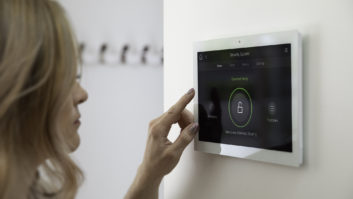Covid has of course caused so many of us to spend more time indoors; we have been forced to work, educate and entertain ourselves at home far beyond what we are used to. This triggered a well-documented surge in TV sales and accelerated a spiralling demand for subscriptions such
as Netflix and Disney Plus. More generally the pandemic also placed greater emphasis on the myriad CE devices in our homes and perhaps more importantly, the technologies attempting to link them together under the ‘smart home’ umbrella.
On the smart home horizon
‘Smart home’ is still a relatively disjointed concept for most consumers. They might buy a smart speaker here and a smart camera there, perhaps an Amazon Ring doorbell. However, unless the owner has planned ahead, they will often find that their devices do not communicate with one another. This will often be because they are from different brands using different communications protocols. However, these issues are gradually receding and Futuresource believes that the bewildering range of brands will gradually shake down to a few major players, making the choices clearer and enabling those who buy smart home devices at retail to have a far more coherent experience
in their home.
Diversification of the smart brand landscape
There are distinct moves towards diversification, with leading brands creating a portfolio of connected products, each of which are designed to work together and attract consumers to invest in vendor-specific ecosystems. Product support becomes an expanding problem: these products are not ‘sell and forget’; there are challenges in maintaining software upgrades and ensuring lifetime value for smart home devices already in the market. However, finding the optimum moment to discontinue support for legacy devices without alienating customers or weakening brand value is a delicate proposition. To better serve their customers, we expect to see leading consumer brands refine their own smartphone and tablet apps to widen their appeal in this market. The important distinction here is that apps are no longer tied to specific products and instead are linked to the wider ecosystem. Whilst this approach isn’t unique, it is becoming more common, and this is enabling CE companies to integrate more tightly into the smart home and deliver an experience to customers that is far more influential than presenting themselves as a disjointed brand across individual devices.
The age of AI is upon us
In terms of technologies, AI is now being used to optimise energy consumption and improve efficiency in the context of the smart home, as a key element in AIoT; the combination of AI and the internet of things. This is entirely plausible although it’s unclear on the efficacy of this approach across disparate smart home ecosystems, only loosely connected today via isolated apps and separate IoT hubs. Nevertheless, the consumer electronics industry recognises the need for consensus on how to communicate between the differing mechanisms being employed by various companies, given
how unlikely it is for consumers to purchase a full range of products from within a manufacturer’s own ecosystem.
Voice control beyond
the speaker
Voice control resides largely with smart speakers today, but we expect this to extend into other devices. The expansion of neural network technology in application processors is enabling swift migration of voice technology towards the edge, running on smart home devices themselves. We expect to see the introduction of domain-specific assistants, presenting alternative task-centric voice solutions. Running entirely on a device, with no requirement for cloud connectivity, these have a wide phraseology mapped onto a smaller set of intents targeted towards specific applications. There will be optimisation of voice components, enabling tighter integration with edge-based AI, and enriched natural language processing. This is decreasing latency in responses and further increasing privacy, both of which are key elements in the strategy. Voice assistants will become proactive in anticipating user intent and this may be combined with intelligent interjection, where the assistant can join conversations and, theoretically, influence user thoughts and behaviour. Ultimately, AI will extend beyond voice, leading to intelligent homes capable of more autonomy, helping to propel the industry forward beyond simple ‘command and control’ functions.
Smart tech enabling independence
One area of particular interest is the potential for smart home to enable people to live independently, whilst being adequately monitored by their loved ones. Simple smart devices such as doorbells, cameras, lighting and motion sensors will increasingly be adopted in a bid to support family members and friends remotely. Behavioural analytics, driven by AI, enables smart home devices to identify changes in normal patterns of usage, a potential early sign that something may be amiss. Additionally, those who have restricted mobility within their home have much to gain from using devices which enable them to control the devices in their home using voice commands.
The rise in fire detectors
and lighting
Whilst all areas of the smart home sector have seen an increase, with it being a relatively new market, some have fared better than others as a result of the lockdown. Detectors and lighting have been positively influenced, with consumers appearing to have found a greater need to protect their families against possible disasters, such
as fires or smoke, as the result of spending more time at home. Householders have also invested in smart lighting in order to enjoy its benefits both indoors and within the garden. Smart home vendors, such as Signify, capitalised on this by extending their range of products suitable for outdoor use.
Meanwhile security devices such as smart locks and cameras would naturally have performed better if people were spending less time at home.
The benefits of smart home in a post-Covid world
When the pandemic recedes, we will of course have to adapt to a new normal,
with home working in particular increasing the time spent in our homes. However, as time goes by we will return to old ways in terms of leaving home for recreational purposes; for sports, leisure, holidays,
etc. This will no doubt play into the use case of people monitoring their homes remotely for reasons of security and energy efficiency. It is very likely that hygiene issues will also be a higher
priority in consumers’ minds, leading to greater demand for air quality monitoring and touch-free controls. The perennial
key drivers for smart home adoption,
such as convenience, security and
energy saving, will continue to exert
their influence.
Home working post-pandemic
Thanks to Covid-19, a large percentage of the world’s workforce has had to adapt to working from home, rushing to set up a second office and gradually working out the challenges and the kit required to do this effectively. These topics were evident in the Futuresource Home Working survey results, which indicate that for many, the trend of home working is not going to go away post-lockdown restrictions. It suggests that hybrid working (splitting the working week between the office and home) is expected to become the norm for most respondents; a shift from 43 per cent pre-Covid to 56 per cent post-Covid.
Furthermore, the survey explores the return to office plans and role-based hybrid working by seniority, which demonstrates that junior to mid-management grades are more likely to work from home one-to-two days per week compared to higher grades. The split is more even among those who are working at home three-to-four days per week, but the trend does increase across the more senior roles. This provides an ideal opportunity for suppliers of products, services and installers when it comes to the second office.
The big residential install opportunity
So how do these changes and trends in technology development and adoption impact the channel? Purchasing habits were interrupted in 2020, with much of physical retail shut for lengthy periods and consumers therefore relying on online reviews to buy over the internet. This is
fine when purchasing products for isolated usage but as highlighted here, becomes
an issue when moving towards a truly smart home approach. Futuresource expects the role of physical retail to play
an important part in educating consumers, supported by the development of vendor ecosystems.
This only represents half of the story when it comes to opportunities, certainly in the short term, for residential installer channels to service a rapidly growing user base with smart home ecosystems. However, Futuresource believes the home working trend is even more interesting for this channel, who are already very comfortable with the challenges residential install brings. The pandemic will leave a large base of home workers that require service and support and whilst the majority of issues will be resolved via remote helpdesks, there will be a clear need for on-site support where the average AV/IT reseller will not have the skills to service. Futuresource expects to see proactive residential installer building services fulfil the demand from end users and be paid for by the corporate pound.
A fascinating time ahead.
For more information about the Futuresource Smart Home, Smart Appliance, Home Working or AV Managed Systems Reports, please contact [email protected].







